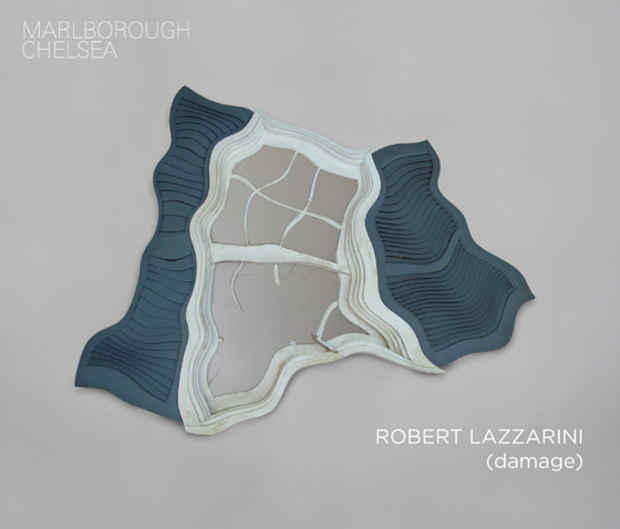Robert Lazzarini "(damage)"
Marlborough Chelsea

This event has ended.
With (damage), Robert Lazzarini charts a new American landscape, one that is fragmented, broken, disturbed and, of course, distorted. We are given a safe, a window, a liquor sign, a motel door, a chain-link fence topped by concertina wire, a padlock and chain, all blown or busted, all cut free from their original setting, and all bent by some force other than the intimately human (such as a kick, a cut, or a punch) even as they exhibit the effects of the latter as well. Each work is at once ruin and representation, a rethinking of the ‘picturesque’, where irregularity, dynamism, and fluidity do not combine to produce an aesthetic lesson on nature’s well-ordered world but reveal instead a landscape neither beautiful nor sublime but seemingly very far from equilibrium.
Whereas Lazzarini’s earlier work tapped the legacy of minimalism and its attendant phenomenology of perception, (damage) picks up a distinctively postminimalist thread, and builds on Robert Smithson’s dialectical landscapes, Gordon Matta-Clark’s cuts, and Cady Noland’s psychopathology of the American dream. In these artists’ hands, objects alone could no longer entertain their ‘being-apart’ from the world, but nor could the mere (Pop) image guarantee any deeper engagement with it. One had to deal with ‘things’ and figure out how to make them reveal their complexities, their contradictions, their compromised lives. So it is with (damage), where every thing’s integrity (not to mention utility) has been compromised, and everything stands in for an (absent) landscape that is both beyond us and beyond repair.
Primarily a sculptor, Lazzarini is best known for making common objects that have been subjected to compound distortions which have the effect of confusing visual and haptic space, complicating the space of pictures and the space of things. Lazzarini also alters the physical spaces in which these objects are seen — the ground to the object’s figure — which adds to the disorienting effect that the work exerts on its audience.Offering no ideal point of view, and so compelling its viewers to walk around the work, Lazzarini’s sculptures trace their lineage back to the 1960s, to the introduction of phenomenology into the discourse of art and to minimalism.
His work has been exhibited both nationally and internationally in venues such as The Modern Art Museum of Fort Worth, The Whitney Museum of American Art, The Virginia Museum of Fine Arts, The Wadsworth Atheneum, The Tapei Museum of Contemporary Art, The Deste Foundation, and The Kunsthalle Berne. Selected permanent collections include MoMA, NY, The Hirshhorn Museum and Sculpture Garden, Washington, DC, Milwaulkee Art Museum, Milwaukee, WI, The Mint Museum, Charlotte, NC, The Newark Museum, Newark, NJ, The Toledo Museum of Art, Toledo, OH, Walker Art Center, Minneapolis, MN, Whitney Museum of American Art, New York, NY, and Davidson College, Davidson, NC. Lazzarini has an upcoming exhibition at Wadsworth Atheneum, Connecticut. He lives and works in New York and is represented in New York by Marlborough Chelsea.
Media
Schedule
from January 10, 2013 to February 22, 2013
Opening Reception on 2013-01-10 from 18:00 to 20:00